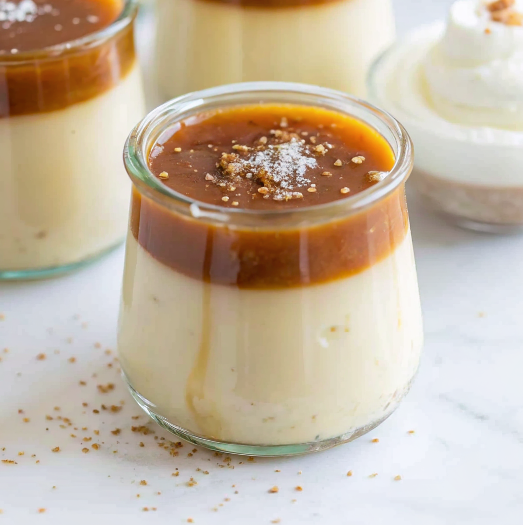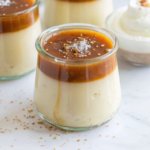Discover the secret to creating restaurant-quality butterscotch budino that rivals Italy’s finest trattorias. This silky Italian dessert captivates with its rich caramel notes and velvety texture, yet many home cooks struggle with achieving the perfect consistency and deep butterscotch budino flavor that makes this dessert truly exceptional. Unlike simple light textured snacks, this indulgent pudding requires precise technique and understanding of traditional custard-making principles.
Master this authentic Italian pudding with foolproof techniques and professional tips that guarantee success every time. Our comprehensive guide addresses common pitfalls, provides troubleshooting solutions, and shares the cultural context that makes butterscotch budino a beloved dessert across Italy and beyond.
Table of Contents
What Is Butterscotch Budino: Understanding This Italian Classic
Butterscotch budino represents the pinnacle of Italian dessert craftsmanship, combining the rich tradition of custard-making with the complex flavors of caramelized brown sugar. Originating in Northern Italy’s Piedmont region, this dessert gained popularity throughout the country as a sophisticated alternative to basic puddings.
Origins and Cultural Significance
The term “budino” derives from the Italian word for pudding, but this dessert transcends simple pudding categories. Italian families traditionally served budino during special occasions and Sunday dinners, often preparing it hours ahead to achieve the ideal chilled consistency. Regional variations include Tuscan budino with local honey additions and Venetian versions featuring subtle vanilla bean infusions.
Texture and Flavor Profile
Authentic butterscotch budino achieves a silky, spoon-coating consistency that’s denser than regular pudding yet lighter than crème brûlée. The flavor profile balances sweet caramel notes with subtle hints of salt and vanilla, creating depth that develops as the dessert chills. Professional chefs describe the ideal texture as “nappe consistency” – smooth enough to coat a spoon without dripping immediately.
Difference from Regular Pudding
Unlike American-style puddings that rely heavily on cornstarch, butterscotch budino uses egg yolks as the primary thickening agent. This technique creates superior richness and allows the butterscotch flavors to shine without starchy interference. The cooking method also differs significantly, requiring careful temperature control and constant stirring to prevent curdling.
Essential Ingredients for Perfect Butterscotch Budino

Creating exceptional butterscotch budino begins with selecting premium ingredients that contribute to both flavor and texture. Each component plays a crucial role in achieving the signature silky consistency and rich taste profile that defines this Italian classic.
Quality Ingredient Selection
Brown sugar forms the foundation of butterscotch flavor – choose dark brown sugar for deeper molasses notes or light brown for subtler sweetness. Heavy cream with at least 35% fat content ensures proper richness and stability during cooking. Fresh egg yolks from pasture-raised sources provide superior binding properties and create the characteristic golden color.
Pure vanilla extract enhances the caramel notes without overpowering the delicate balance. Sea salt or kosher salt amplifies sweetness while adding complexity. High-quality unsalted butter contributes to the smooth mouthfeel and helps create the glossy surface that characterizes perfect budino.
Substitution Options
For dietary modifications, coconut cream can replace heavy cream, though the flavor profile will shift slightly. Coconut sugar substitutes well for brown sugar while maintaining caramel-like notes. Plant-based butter alternatives work effectively, though they may affect the final texture slightly.
Those avoiding eggs can use cornstarch and arrowroot powder combinations, though the result will differ from traditional butterscotch budino texture. Dairy-free milk alternatives like oat or cashew milk provide acceptable substitutions when combined with additional thickening agents.
Equipment Requirements
Heavy-bottomed saucepan prevents scorching during caramel preparation. Fine-mesh strainer removes any lumps for silky smoothness. Digital thermometer ensures precise temperature control. Whisk with comfortable grip handles continuous stirring requirements. Individual ramekins or glasses provide ideal serving portions and presentation.
Step-by-Step Butterscotch Budino Recipe
Follow this detailed butterscotch budino recipe to create authentic Italian dessert perfection. Each step builds upon the previous technique, ensuring consistent results and professional-quality outcomes.
Caramel Preparation Technique
Begin by combining 1 cup dark brown sugar with 2 tablespoons water in your heavy-bottomed saucepan. Heat over medium heat without stirring until edges begin bubbling, approximately 3-4 minutes. Swirl the pan gently to distribute heat evenly, allowing the sugar to dissolve completely before increasing temperature.
Continue cooking until the mixture reaches deep amber color and releases rich caramel aromas. This process typically takes 8-10 minutes, but visual and aromatic cues matter more than strict timing. The caramel should coat a wooden spoon and drop in thick ribbons when ready.

Custard Base Creation
While caramel cooks, whisk together 6 large egg yolks in a separate bowl until smooth and pale. Gradually heat 2 cups heavy cream in another saucepan until steaming but not boiling, maintaining temperature around 180°F. This preparation ensures smooth integration when combining components.
Remove caramel from heat and slowly add the warm cream while whisking constantly. The mixture will bubble vigorously initially – this reaction is normal and expected. Continue whisking until completely smooth, then return to low heat if needed to dissolve any remaining sugar crystals.
Tempering and Cooking Process
Gradually add one ladle of hot cream mixture to the egg yolks while whisking continuously, preventing the eggs from cooking. Repeat this tempering process 3-4 times until yolks are warmed, then slowly stream the remaining cream mixture while whisking.
Return the combined mixture to the saucepan over low heat, stirring constantly with figure-eight motions. Cook until the mixture coats the back of a spoon and reaches 175°F, typically 5-7 minutes. Strain through fine-mesh strainer into individual serving glasses, removing any lumps. Similar to techniques used in campaign pudding techniques, precision in temperature control prevents curdling.
Cover surface directly with plastic wrap to prevent skin formation, then refrigerate for at least 4 hours or overnight. The butterscotch budino will continue thickening as it chills, developing its characteristic silky texture.
Professional Tips and Troubleshooting Guide
Mastering butterscotch budino requires understanding common challenges and implementing professional techniques that ensure consistent success. These expert tips address frequent issues and provide solutions for achieving perfect results every time.
Common Mistakes to Avoid
Overheating represents the most frequent error in butterscotch budino preparation. Maintaining temperatures below 180°F during custard cooking prevents protein coagulation and ensures smooth texture. Rushing the tempering process often results in scrambled eggs – always add hot liquid gradually while whisking continuously.
Inadequate straining allows lumps to remain in the final product. Always strain the mixture through fine mesh, pressing gently with a spoon to ensure complete smoothness. Skipping the plastic wrap step creates an unpleasant skin on the surface that affects both texture and presentation.
Texture Problem Solutions
If your butterscotch budino turns grainy, the caramel likely overcooked or the custard overheated. Salvage by reheating gently with additional cream while whisking vigorously, then straining again. Professional standards, as outlined in professional pudding standards, emphasize temperature control for optimal texture.
Thin consistency indicates insufficient cooking time or inadequate egg yolk ratios. Return mixture to low heat and cook additional 2-3 minutes until proper nappe consistency develops. Too-thick results suggest overcooking – thin with small amounts of warm cream while whisking.
Flavor Enhancement Tips
Enhance butterscotch depth by browning butter before adding to the caramel base. This technique adds nutty complexity that complements the sweet caramel notes beautifully. A pinch of flaky sea salt sprinkled on top before serving amplifies all flavors and adds sophisticated contrast.
Vanilla bean paste provides more intense flavor than extract, while a tablespoon of cream cheese whisked into the warm base creates extra richness. These professional enhancements elevate homemade butterscotch budino to restaurant quality.
Variations and Flavor Combinations
Explore creative butterscotch budino variations that maintain the classic’s integrity while offering personalized touches. These adaptations accommodate dietary preferences and seasonal ingredients without compromising the dessert’s essential character.
Dietary Modifications
Create dairy-free versions using full-fat coconut milk and coconut cream, maintaining richness while accommodating restrictions. Substitute maple syrup for brown sugar in reduced quantities, adjusting liquid ratios accordingly. Understanding custard science principles helps modify recipes successfully, as detailed in custard science principles.
For reduced-sugar versions, use natural sweeteners like monk fruit or stevia, though flavor profiles will shift slightly. Sugar-free brown sugar substitutes work effectively in caramel preparation when combined with small amounts of molasses for authentic color and taste.
Flavor Additions
Incorporate espresso powder for sophisticated mocha undertones, or add cinnamon and nutmeg for warming spice notes. Orange zest brightens the rich sweetness, while cardamom provides exotic complexity. These additions work best when infused during cream heating, allowing flavors to meld completely.
Toasted nuts like pecans or hazelnuts can be folded into cooled budino for textural contrast. Fresh fruit compotes complement the rich butterscotch beautifully – try pear or apple preparations that echo caramel flavors naturally.
Seasonal Variations
Autumn versions benefit from pumpkin spice additions and graham cracker crumble toppings. Winter preparations work well with peppermint extract and crushed candy toppings. Spring variations incorporate fresh berries and light citrus touches, while summer versions pair beautifully with stone fruit representations.
Holiday presentations can include themed garnishes and flavor profiles – cranberry sauce swirls for harvest celebrations, or rose water for romantic occasions. These seasonal adaptations keep butterscotch budino exciting throughout the year while honoring traditional preparation methods.
Serving, Storage, and Presentation Ideas
Proper serving and storage techniques maximize your butterscotch budino experience while ensuring optimal flavor and texture. Professional presentation elevates this Italian classic from simple dessert to elegant finale worthy of special occasions.
Optimal Serving Temperature
Serve butterscotch budino well-chilled, ideally after 4-6 hours of refrigeration. The ideal serving temperature ranges between 38-42°F, allowing flavors to shine while maintaining silky texture. Remove from refrigeration 10-15 minutes before serving to slightly temper the consistency for easier eating.
Individual portions warm faster than large batches, so plan accordingly when entertaining. Unlike refreshing sweet dessert beverages served immediately, budino benefits from patient chilling that develops complex flavors and perfect texture.
Garnish Suggestions
Classic presentations feature dollops of freshly whipped cream and delicate caramel drizzles. Crushed amaretti cookies provide textural contrast while maintaining Italian authenticity. Fresh berries add color and acidity that balances rich sweetness perfectly.
Professional garnishes include gold leaf accents, edible flowers, or artfully placed mint sprigs. Toasted coconut flakes, chopped toasted nuts, or sea salt flakes create sophisticated finishing touches. These presentations transform simple butterscotch budino into restaurant-worthy desserts.
Storage Guidelines
Properly covered butterscotch budino keeps refrigerated for up to 5 days, maintaining quality when stored correctly. Cover individual portions tightly with plastic wrap, ensuring surface contact prevents skin formation. Glass containers preserve flavors better than plastic alternatives.
Avoid freezing as texture suffers significantly upon thawing. For best results, prepare budino 1-2 days ahead, allowing flavors to develop fully while maintaining optimal consistency. Label containers with preparation dates for food safety tracking.

Frequently Asked Questions
How long does homemade butterscotch budino last in the refrigerator?
Homemade butterscotch budino maintains optimal quality for 4-5 days when properly stored in the refrigerator. Cover individual portions tightly with plastic wrap pressed directly against the surface to prevent skin formation. Signs of spoilage include off odors, mold growth, or separation. For best flavor experience, consume within 3 days of preparation when the texture remains perfectly silky.
Can I make butterscotch budino without heavy cream?
Yes, you can substitute heavy cream with full-fat coconut milk, whole milk mixed with butter, or cashew cream for butterscotch budino preparation. Coconut milk provides the closest texture match, while whole milk requires additional egg yolks for proper consistency. Expect slight flavor variations and potentially thinner consistency with alternative dairy options. Adjust thickening agents accordingly for best results.
Why did my butterscotch budino turn grainy?
Grainy butterscotch budino typically results from overheating the custard base or inadequate tempering of egg yolks. High temperatures cause protein coagulation, creating lumpy texture. Prevention involves maintaining temperatures below 180°F and gradual egg yolk tempering. Salvage grainy budino by gently reheating with additional cream while whisking vigorously, then straining through fine mesh twice.
What’s the best way to prevent skin from forming on budino?
Prevent skin formation by pressing plastic wrap directly against the butterscotch budino surface before refrigerating. This technique eliminates air contact that causes skin development. Alternatively, brush melted butter lightly across the surface or dust with powdered sugar. Remove any skin that forms by gently lifting with a spoon before serving.
Can butterscotch budino be made dairy-free?
Dairy-free butterscotch budino works successfully using coconut cream, cashew milk, or oat milk combined with plant-based butter alternatives. Maintain richness by choosing full-fat alternatives and adding extra thickening agents like cornstarch. Flavor profiles shift slightly with dairy substitutions, but results remain delicious. Allow extra chilling time as plant-based versions may require longer setting periods.
What temperature should I cook butterscotch budino to achieve perfect consistency?
Cook butterscotch budino custard base to exactly 175°F for optimal consistency without curdling. Use an instant-read thermometer for accuracy, maintaining low heat throughout cooking. The mixture should coat a spoon and hold figure-eight patterns when ready. Temperatures above 185°F risk scrambling eggs, while insufficient heating creates thin, unstable texture.
Conclusion
Butterscotch budino represents the perfect marriage of technique and tradition, offering home cooks the opportunity to create sophisticated Italian desserts with confidence. By mastering the fundamental techniques of caramel preparation, proper tempering, and precise temperature control, you’ll consistently achieve the silky texture and rich flavor that makes this dessert truly exceptional.
The key to successful butterscotch budino lies in patience and attention to detail – from carefully monitoring caramel development to gradually building the custard base. These techniques, combined with quality ingredients and proper storage methods, ensure restaurant-quality results that impress family and guests alike.
Whether you choose traditional preparation methods or explore creative variations, the foundational principles remain constant. Remember that practice perfects technique, and each batch teaches valuable lessons about timing, temperature, and texture development. Consider exploring other classic dessert variations to expand your repertoire of elegant, make-ahead desserts that showcase similar custard-making skills.
Share your butterscotch budino creations with confidence, knowing you’ve mastered one of Italy’s most beloved dessert traditions. The combination of rich flavors, silky texture, and elegant presentation makes this dessert perfect for any occasion worthy of something truly special.
Print
Decadent Butterscotch Budino
- Total Time: 3 hours 55 minutes
- Yield: 4 servings 1x
- Diet: Vegetarian
Description
Get ready to fall head over heels for this absolutely stunning Butterscotch Budino that’s about to become your new signature dessert! This creamy, dreamy Italian pudding is pure comfort in a glass—rich, buttery, and impossibly smooth with deep caramel flavors that develop into something magical. The best part? This elegant dessert actually gets better as it chills, making it perfect for stress-free entertaining. With its sophisticated appearance and melt-in-your-mouth texture, guests will think you spent hours in the kitchen when it actually comes together in just 35 minutes of active time. Prepare for serious dessert envy!
Ingredients
- ½ cup packed dark brown sugar
- ¼ teaspoon kosher salt
- ¼ cup water
- 2 tablespoons unsalted butter
- 1½ cups heavy cream
- ¾ cup milk
- 1 large egg
- 2 large egg yolks
- 2 tablespoons cornstarch
- 1 teaspoon cornstarch
- 1 tablespoon white rum
Topping Ideas:
- Lightly sweetened whipped cream
- Salted caramel drizzle
- Crushed amaretti cookies
- Fresh berries for color contrast
Instructions
- Start the Caramel Symphony: Combine brown sugar, salt, and water in a deep, heavy-bottomed saucepan over medium-high heat. Bring to a vigorous boil and cook 7-10 minutes until the mixture turns gorgeously dark and bubbles dramatically—this is where the magic happens!
- Add Richness and Depth: Turn off heat immediately and carefully whisk in butter (expect some serious bubbling!). Slowly stream in heavy cream while whisking—the mixture will bubble up, so stay calm and keep stirring. Return to medium-low heat, stir until completely smooth, then whisk in milk.
- Perfect the Custard Base: In a separate bowl, whisk egg, egg yolks, and all cornstarch until completely smooth. Here’s the key: slowly pour 1 cup of the hot cream mixture into the eggs while whisking constantly—this gentle tempering prevents any scrambling disasters!
- Bring It All Together: Pour the tempered egg mixture back into the saucepan and crank the heat to medium-high. Bring to a gentle simmer, whisking constantly, and cook about 2 minutes until it coats your whisk beautifully and has that perfect pudding consistency.
- Strain for Perfection: Remove from heat and pour immediately through a fine-mesh strainer into a clean bowl—this removes any potential lumps for that silky-smooth finish. Whisk in rum for that sophisticated adult flavor.
- Chill and Set: Divide among 4 beautiful serving glasses. Cool to room temperature (about 20 minutes), then cover with plastic wrap pressed directly onto the surface. Refrigerate 3-4 hours until perfectly set and chilled.
- Serve with Flair: Present your masterpiece chilled with your choice of elegant toppings. Watch as everyone takes that first spoon and their eyes light up with pure dessert joy!
Notes
Pro tip: Don’t rush the caramelization—that deep, dark color is what gives you incredible butterscotch flavor! The rum adds sophistication but can be swapped for vanilla extract if preferred. This dessert is a total make-ahead champion and actually tastes better after chilling overnight. Perfect for dinner parties since you can make it completely ahead of time. Store covered in the fridge for up to 4 days, though it probably won’t last that long! For extra indulgence, serve with a small spoon of salted caramel on the side.
- Prep Time: 15 minutes
- Cook Time: 20 minutes
- Category: Dessert
- Method: Stovetop Custard
- Cuisine: Italian-Inspired
Nutrition
- Serving Size: 1 serving (1/4 of recipe)
- Calories: 385
- Sugar: 32g
- Sodium: 180mg
- Fat: 26g
- Saturated Fat: 16g
- Unsaturated Fat: 10g
- Trans Fat: 0g
- Carbohydrates: 35g
- Fiber: 0g
- Protein: 5g
- Cholesterol: 185mg
